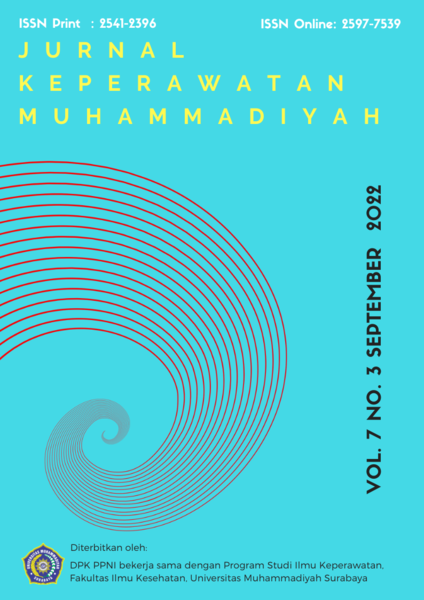Perbedaan Self-Efficacy Pencegahan Hipertensi Sebelum dan Sesudah Diberikan Edukasi Menggunakan Workbook pada Tenaga Kependidikan Kesehatan pada Salah Satu Perguruan Tinggi di Jawa Barat
DOI:
https://doi.org/10.30651/jkm.v7i3.13403Keywords:
Education, Hypertension, Self-efficacy, Workbook.Abstract
There are many health education methods, most of which do not involve the participants actively. Workbooks are educational media that encourage a person's active role and are expected to increase self-efficacy, where self-efficacy itself is a predictor of self-care management behavior. This study aimed to identify differences in hypertension prevention's self-efficacy before and after health education using a workbook. This study used a quasi-experimental method with a pre-post-test design with a control group. This study's population was teaching staff in two health faculties at one of the universities in West Java, Indonesia. The sample was determined using the convenience sampling technique and obtained 24 respondents divided into the control and intervention groups. Data collection using the instrument "self-efficacy for prevention of hypertension." The data were analyzed using the median and frequency distribution, while for the different tests, the Wilcoxon test and the Mann Whitney test were used. The median pre-test for self-efficacy was 105 and 110, while the post-test was 104.5 and 110.5 in the control and intervention groups. While the p-value of the difference test between the two groups before the intervention was 0.326 (p> 0.05), while after the intervention, the p-value was 0.002 (p <0.05). This study indicated a significant difference in the self-efficacy of hypertension prevention after being given education using a workbook in the two groups, where the self-efficacy score in the intervention group was higher than the control group. As a recommendation, workbooks can be used as an educational tool for hypertension prevention to increase self-efficacy.
References
Guideline for the Prevention, Detection, Evaluation and Management of High Blood Pressure in Adults. Retrieved December 30, 2017, from https://healthmetrics.heart.org/wp-content/uploads/2017/11/Detailed-Summary.pdf
Asrikan, M. A. (2016). Hubungan Self Efficacy dengan Self Care Activity Pada Pasien Dengan Diabetes Mellitus Tipe II Di RSUD Pandan Arang Boyolali. Surakarta: Stikes Kusuma Husada. Retrieved from http://digilib.stikeskusumahusada.ac.id/files/disk1/33/01-gdl-muhammadar-1607-1-artikel-n.pdf
Badan Penelitian dan Pengembangan Kesehatan. (2013). Riset Kesehatan Dasar 2013. Jakarta. Retrieved from www.depkes.go.id/resources/download/general/Hasil Riskesdas 2013.pdf
Bandura, A. (2010). Self-efficacy. In The Corsini Encyclopedia of Psychology (Vol. 4, pp. 71–81). Hoboken, NJ, USA: John Wiley & Sons, Inc. https://doi.org/10.1002/9780470479216.corpsy0836
Bandura, A. (1997). Self-efficacy: The exercise of control. Newyork: W. H. Freeman and Company.
Departemen Kesehatan RI.(2017). Penyakit Jantung Penyebab Kematian Tertinggi, Kemenkes Ingatkan CERDIK. Retrieves from http://www.depkes.go.id/article/view/17073100005/penyakit-jantung-penyebab-kematian-tertinggi-kemenkes-ingatkan-cerdik-.html.
Endang, S. (2010). Hipertensi penyebab Kematian Nomor Tiga di Indonesia. Retrieved January 15, 2018, from http://www.depkes.go.id/article/view/810/hipertensi-penyebab-kematian-nomor-tiga.
Ferdianto, Ricky. (2014). Hubungan Antara Efikasi Diri Dengan Stres Kerja Pada Karyawan Solopos.Skripsi (tidak diterbitkan). Surakarta: Fakultas Psikologi Universitas Muhammadiyah Surakarta.
Firmawati, E., Rasyida, Z. M., & Santosa, T. (2011). Pengaruh Blog Edukatif Tentang Hipertensi Terhadap Pengetahuan Tentang Hipertensi dan Perilaku Diet Hipertensi pada Pasien Hipertensi di Wilayah Kerja Puskesmas Wirobrajan Yogyakarta. Muhammadiyah Journal of Nursing, 99–108.
Hu, H., Li, G., & Arao, T. (2013). Validation of a Chinese Version of the Self-efficacy for Managing Chronic Disease 6-Item Scale in Patients with Hypertension in Primary Care, 2013, 1–5. https://doi.org/10.1155/29013/298986
Indrastuti.(2012). Hubungan antara Efikasi Diri dengan Prestasi Akademik dan Kecemasan Menyelesaikan Studi pada Mahasiswa Tingkat Akhir.Skripsi (tidak diterbitkan). Surakarta: Fakultas Psikologi Universitas Muhammadiyah Surakarta
Lisiswanti, R., Dananda, D.N.A. (2016). Upaya Pencegahan Hipertensi. Medical Journal of Lampung University, Vol. 5 (3), 50-54. Retrieved January 26, 2018, from https://www.juke.kedokteran.unila.ac.id
Maghfiroh, I. L. (2016). Pengaruh Edukasi Manajemen Diri Terhadap Self-efficacy, Perilaku Manajemen Diri, dan Kulaitas Hidup Pasien Asma di Rumah Sakit Paru dr. Rotinsulu Bandung, 8(2), 71–81. Retrieved from http://jurnal.stikesmuhla.ac.id/wp-content/uploads/2016/12/71-81-Isni-Lailatul-M.pdf
National Heart Lung and Blood. (2016). What Is High Blood Pressure? Retrieved October 4, 2017, from http://www.heart.org/idc/groups/heart-public/@wcm/@hcm/documents/downloadable/ucm_300310.pdf
National Heart Lung and Blood Institute. (2015). Lowering Your Blood Pressure With DASH. Retrieved January 26, 2018, from https://www.nhlbi.nih.gov/files/docs/public/heart/new_dash.pdf
National Heart Lung and Blood Institute. (2017). NIH’s SPRINT Trial Played a Key Role in the Evolution of the New Blood Pressure Guidelines. Retrieved January 4, 2018, from https://www.nhlbi.nih.gov/news/2017/nihs-sprint-trial-played-key-role-evolution-new-blood-pressure-guidelines
Nuraeni, A., Mirwanti, R., & Anna, A. (2017). Upaya Pencegahan dan Perawatan Hipertensi di Rumah Melalui Media Pembelajaran Bagi Masyarakat di Kabupaten Pangandaran.(Unpublished)
Pajares, F. (2002).Overview o f social cognitive theory and of self-efficacy.US: Emorv Education.
Peterson, J. C., Link, A. R., Jobe, J. B., Winston, G. J., Maria Klimasiefski, E., & Allegrante, J. P. (2014). Developing Self-management education in coronary artery disease. Heart and Lung: Journal of Acute and Critical Care. 43(2), 133-139. https://doi.org/10.1016/j.hrtlng.2013.11.006
Pratiwi, Nindyatri. (2014). Pengaruh Vicarious Experience Terhadap Self Efficacy Berwirausaha Pada Siswa SMK Negeri 2 Salatiga. Surakarta: Fakultas Psikologi Universitas Muhammadiyah Surakarta.
Sallis, J. F., Owen, N., & Fisher, E. B. (2008). Health Behavior and Health Education. In K. Glanz, B. K. Rimer, & K. Viswanath (Eds.), Health Behavior and Health Education: Theory, Research, and Practice (4th ed., pp. 465–485). https://doi.org/10.7326/0003-4819-116-4-350_1
Smeltzer, S. C., & Bare, B. G. (1999). Buku Ajar Keperawatan Medikal Bedah Brunner & Suddarth. (E. Monica, Ed.) (8th ed.). Jakarta: EGC.
Smith, L., Bosnic-Anticevich, S., Mitchell, B., Saini, B., Krass, I., & Armour, C. (2007).Treating asthma with a self- management model of illness behaviour in an
Australian community pharmacy setting. Social Science & Medicine, 64, 1501-1511.
Stretcher, V., & Rosenstock, I. M. (1997). The Health Belief Model (pp. 31–36). Jones and Bartlett. https://doi.org/10.1111/j.1365-2648.2010.05450.x
World Health Organization. (1996). WHOQOL-BREF. Retrieved October 9, 2017, from http://www.who.int/mental_health/media/en/76.pdf
World Health Organization. (2003). Adherence to Long-Term Therapies.
World Health Organization. (2010). Global Recommendation On Physical Activity For Health. Switzerland.
World Health Organization. (2013). A global brief on Hyper  tension World Health Day 2013. Switzerland. Retrieved from http://apps.who.int/iris/bitstream/10665/79059/1/WHO_DCO_WHD_2013.2_eng.pdf?ua=1
Downloads
Published
Issue
Section
License
- Penulis tetap memegang hak atas karyanya dan memberikan hak publikasi pertama kepada jurnal ini yang secara simultan karya tersebut dilisensikan di bawah:Â Creative Commons Attribution-ShareAlike 4.0 International (CC BY-SA 4.0)













